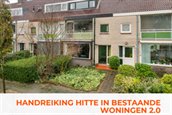Guidelines for heat in existing houses
These interactive guidelines compile the latest insights into factors that determine the temperature in houses and into measures that reduce indoor temperatures. Ample attention is paid to such vulnerable groups as the elderly and low-income families. The guidelines come with an Excel sheet to assign your home a heat label and with a background document containing details regarding the study underpinning the guidelines and the heat label.
For whom?
For municipal staff and housing corporations.
How can the document be used?
The guidelines are intended to combat heat in houses. They comprise five components: the study underpinning the guidelines; a summary of the main outcomes and recommendations; and the three different levels at which heat can be combated: at the area level, at the building level, and at the user level. Completing the heat label Excel sheet will enable users to determine the risk of heat issues for various types of houses. Filling in all the fields will produce a label that ranges from A (very low risk of overheating) to E (very high risk of overheating).
Who has developed the document?
The Guidelines for Heat in Existing Houses 2.0 have been developed within the NKWK Climate-proof Cities focus area (NKWK-KBS). They are based on the NKWK study into “Heat in Houses” that was conducted in 2021 and continued in 2022. The parties involved are Amsterdam University of Applied Sciences, TAUW, National Institute for Public Health and the Environment RIVM, Royal Haskoning DHV, Sweco, and RIGO Research and Advice.
Date of publication
February 2023
